A Review of Computer Technologies: Raspberry Pi, 5G & OS Systems
VerifiedAdded on 2023/04/10
|13
|3231
|457
Homework Assignment
AI Summary
This assignment provides a comprehensive overview of several key computer technologies. It begins by examining the impact of 5G technology on processing speeds and artificial intelligence, highlighting its potential to enhance wireless internet access and extended reality experiences. The assignment then explores the use of Raspberry Pi in healthcare, specifically in building patient monitors, detailing the hardware and software components involved. A comparison between Raspberry Pi and modern PCs/laptops follows, focusing on processor architecture, RAM, and power consumption. The discussion extends to the increasing speed of computers, attributing it to advancements in processor speed and RAM technology. Finally, the assignment contrasts Windows and Linux operating systems, highlighting their technical differences in accessibility, command-line interface, and security, and investigates new technical developments in operating systems, focusing on Microsoft's Home OS for home automation. Desklib offers a platform for students to access this and other solved assignments.
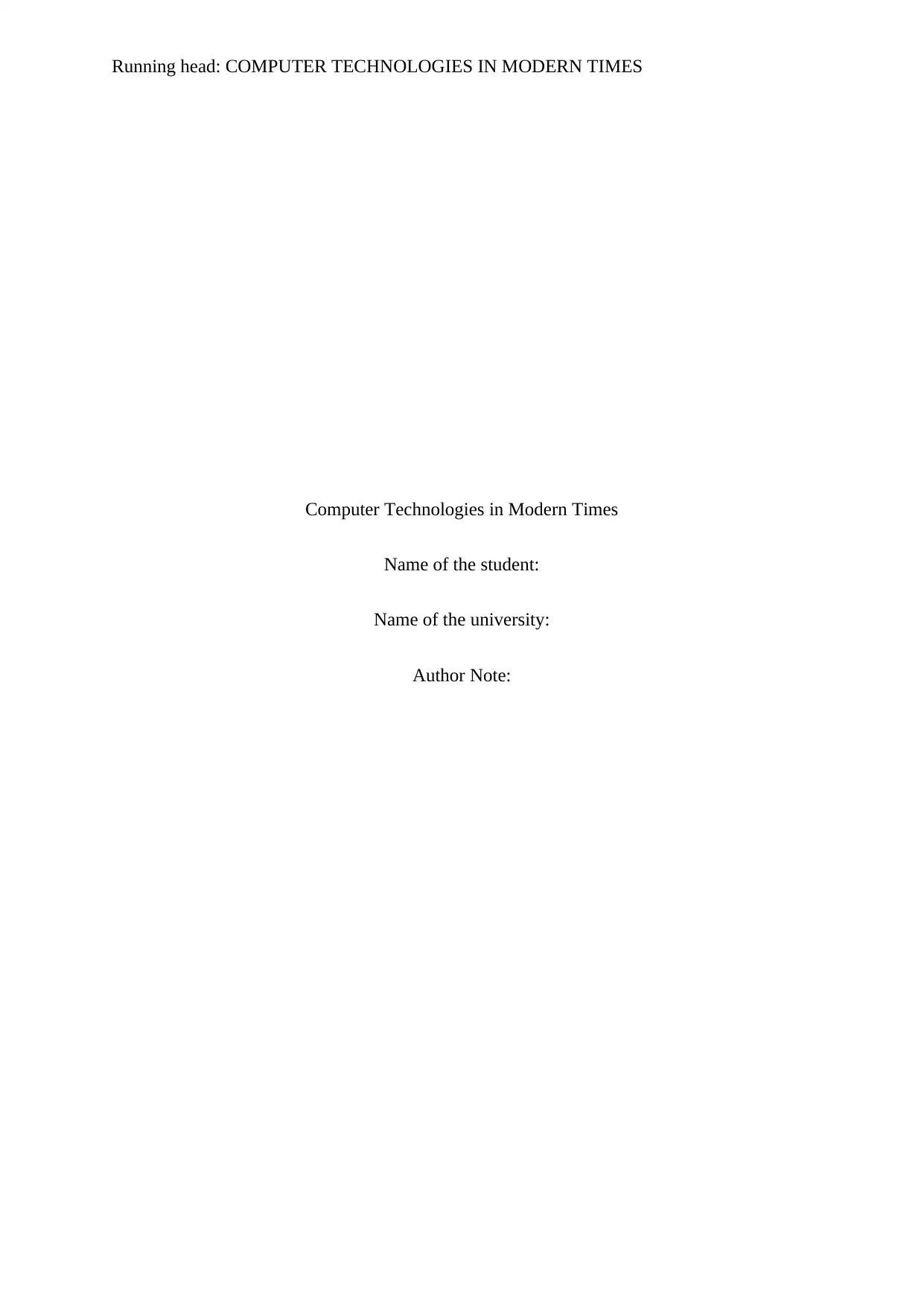
Running head: COMPUTER TECHNOLOGIES IN MODERN TIMES
Computer Technologies in Modern Times
Name of the student:
Name of the university:
Author Note:
Computer Technologies in Modern Times
Name of the student:
Name of the university:
Author Note:
Paraphrase This Document
Need a fresh take? Get an instant paraphrase of this document with our AI Paraphraser
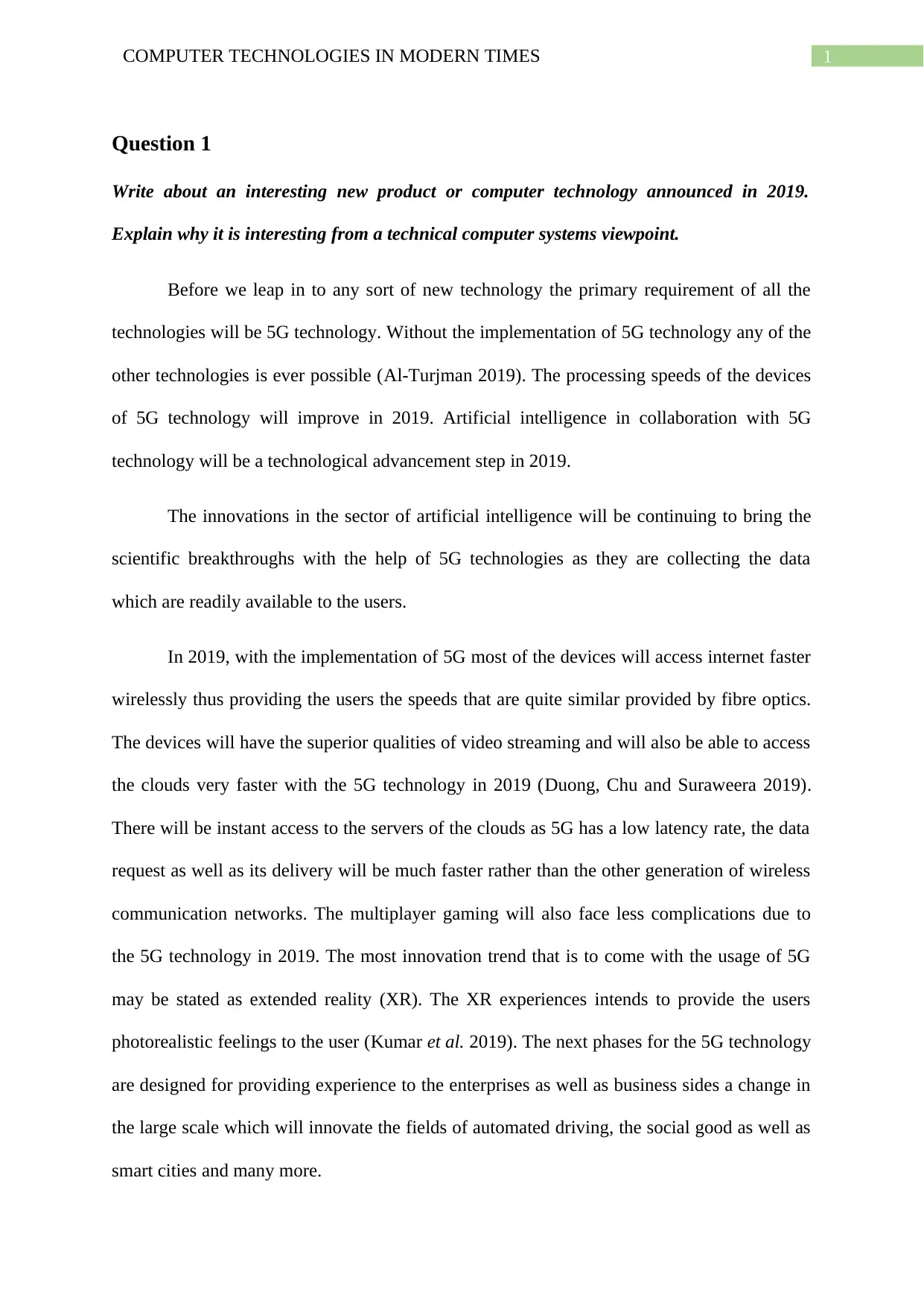
1COMPUTER TECHNOLOGIES IN MODERN TIMES
Question 1
Write about an interesting new product or computer technology announced in 2019.
Explain why it is interesting from a technical computer systems viewpoint.
Before we leap in to any sort of new technology the primary requirement of all the
technologies will be 5G technology. Without the implementation of 5G technology any of the
other technologies is ever possible (Al-Turjman 2019). The processing speeds of the devices
of 5G technology will improve in 2019. Artificial intelligence in collaboration with 5G
technology will be a technological advancement step in 2019.
The innovations in the sector of artificial intelligence will be continuing to bring the
scientific breakthroughs with the help of 5G technologies as they are collecting the data
which are readily available to the users.
In 2019, with the implementation of 5G most of the devices will access internet faster
wirelessly thus providing the users the speeds that are quite similar provided by fibre optics.
The devices will have the superior qualities of video streaming and will also be able to access
the clouds very faster with the 5G technology in 2019 (Duong, Chu and Suraweera 2019).
There will be instant access to the servers of the clouds as 5G has a low latency rate, the data
request as well as its delivery will be much faster rather than the other generation of wireless
communication networks. The multiplayer gaming will also face less complications due to
the 5G technology in 2019. The most innovation trend that is to come with the usage of 5G
may be stated as extended reality (XR). The XR experiences intends to provide the users
photorealistic feelings to the user (Kumar et al. 2019). The next phases for the 5G technology
are designed for providing experience to the enterprises as well as business sides a change in
the large scale which will innovate the fields of automated driving, the social good as well as
smart cities and many more.
Question 1
Write about an interesting new product or computer technology announced in 2019.
Explain why it is interesting from a technical computer systems viewpoint.
Before we leap in to any sort of new technology the primary requirement of all the
technologies will be 5G technology. Without the implementation of 5G technology any of the
other technologies is ever possible (Al-Turjman 2019). The processing speeds of the devices
of 5G technology will improve in 2019. Artificial intelligence in collaboration with 5G
technology will be a technological advancement step in 2019.
The innovations in the sector of artificial intelligence will be continuing to bring the
scientific breakthroughs with the help of 5G technologies as they are collecting the data
which are readily available to the users.
In 2019, with the implementation of 5G most of the devices will access internet faster
wirelessly thus providing the users the speeds that are quite similar provided by fibre optics.
The devices will have the superior qualities of video streaming and will also be able to access
the clouds very faster with the 5G technology in 2019 (Duong, Chu and Suraweera 2019).
There will be instant access to the servers of the clouds as 5G has a low latency rate, the data
request as well as its delivery will be much faster rather than the other generation of wireless
communication networks. The multiplayer gaming will also face less complications due to
the 5G technology in 2019. The most innovation trend that is to come with the usage of 5G
may be stated as extended reality (XR). The XR experiences intends to provide the users
photorealistic feelings to the user (Kumar et al. 2019). The next phases for the 5G technology
are designed for providing experience to the enterprises as well as business sides a change in
the large scale which will innovate the fields of automated driving, the social good as well as
smart cities and many more.
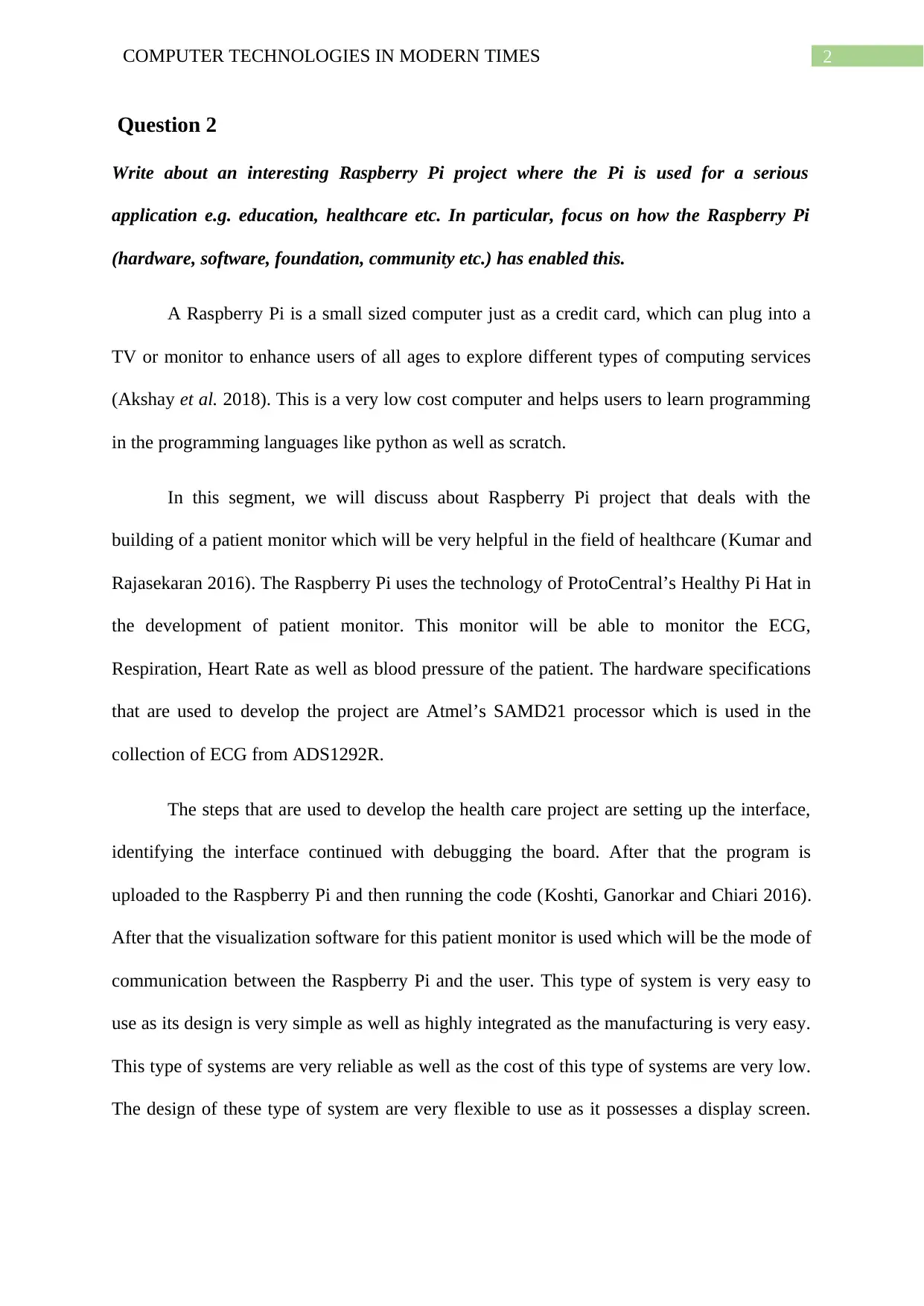
2COMPUTER TECHNOLOGIES IN MODERN TIMES
Question 2
Write about an interesting Raspberry Pi project where the Pi is used for a serious
application e.g. education, healthcare etc. In particular, focus on how the Raspberry Pi
(hardware, software, foundation, community etc.) has enabled this.
A Raspberry Pi is a small sized computer just as a credit card, which can plug into a
TV or monitor to enhance users of all ages to explore different types of computing services
(Akshay et al. 2018). This is a very low cost computer and helps users to learn programming
in the programming languages like python as well as scratch.
In this segment, we will discuss about Raspberry Pi project that deals with the
building of a patient monitor which will be very helpful in the field of healthcare (Kumar and
Rajasekaran 2016). The Raspberry Pi uses the technology of ProtoCentral’s Healthy Pi Hat in
the development of patient monitor. This monitor will be able to monitor the ECG,
Respiration, Heart Rate as well as blood pressure of the patient. The hardware specifications
that are used to develop the project are Atmel’s SAMD21 processor which is used in the
collection of ECG from ADS1292R.
The steps that are used to develop the health care project are setting up the interface,
identifying the interface continued with debugging the board. After that the program is
uploaded to the Raspberry Pi and then running the code (Koshti, Ganorkar and Chiari 2016).
After that the visualization software for this patient monitor is used which will be the mode of
communication between the Raspberry Pi and the user. This type of system is very easy to
use as its design is very simple as well as highly integrated as the manufacturing is very easy.
This type of systems are very reliable as well as the cost of this type of systems are very low.
The design of these type of system are very flexible to use as it possesses a display screen.
Question 2
Write about an interesting Raspberry Pi project where the Pi is used for a serious
application e.g. education, healthcare etc. In particular, focus on how the Raspberry Pi
(hardware, software, foundation, community etc.) has enabled this.
A Raspberry Pi is a small sized computer just as a credit card, which can plug into a
TV or monitor to enhance users of all ages to explore different types of computing services
(Akshay et al. 2018). This is a very low cost computer and helps users to learn programming
in the programming languages like python as well as scratch.
In this segment, we will discuss about Raspberry Pi project that deals with the
building of a patient monitor which will be very helpful in the field of healthcare (Kumar and
Rajasekaran 2016). The Raspberry Pi uses the technology of ProtoCentral’s Healthy Pi Hat in
the development of patient monitor. This monitor will be able to monitor the ECG,
Respiration, Heart Rate as well as blood pressure of the patient. The hardware specifications
that are used to develop the project are Atmel’s SAMD21 processor which is used in the
collection of ECG from ADS1292R.
The steps that are used to develop the health care project are setting up the interface,
identifying the interface continued with debugging the board. After that the program is
uploaded to the Raspberry Pi and then running the code (Koshti, Ganorkar and Chiari 2016).
After that the visualization software for this patient monitor is used which will be the mode of
communication between the Raspberry Pi and the user. This type of system is very easy to
use as its design is very simple as well as highly integrated as the manufacturing is very easy.
This type of systems are very reliable as well as the cost of this type of systems are very low.
The design of these type of system are very flexible to use as it possesses a display screen.
⊘ This is a preview!⊘
Do you want full access?
Subscribe today to unlock all pages.

Trusted by 1+ million students worldwide
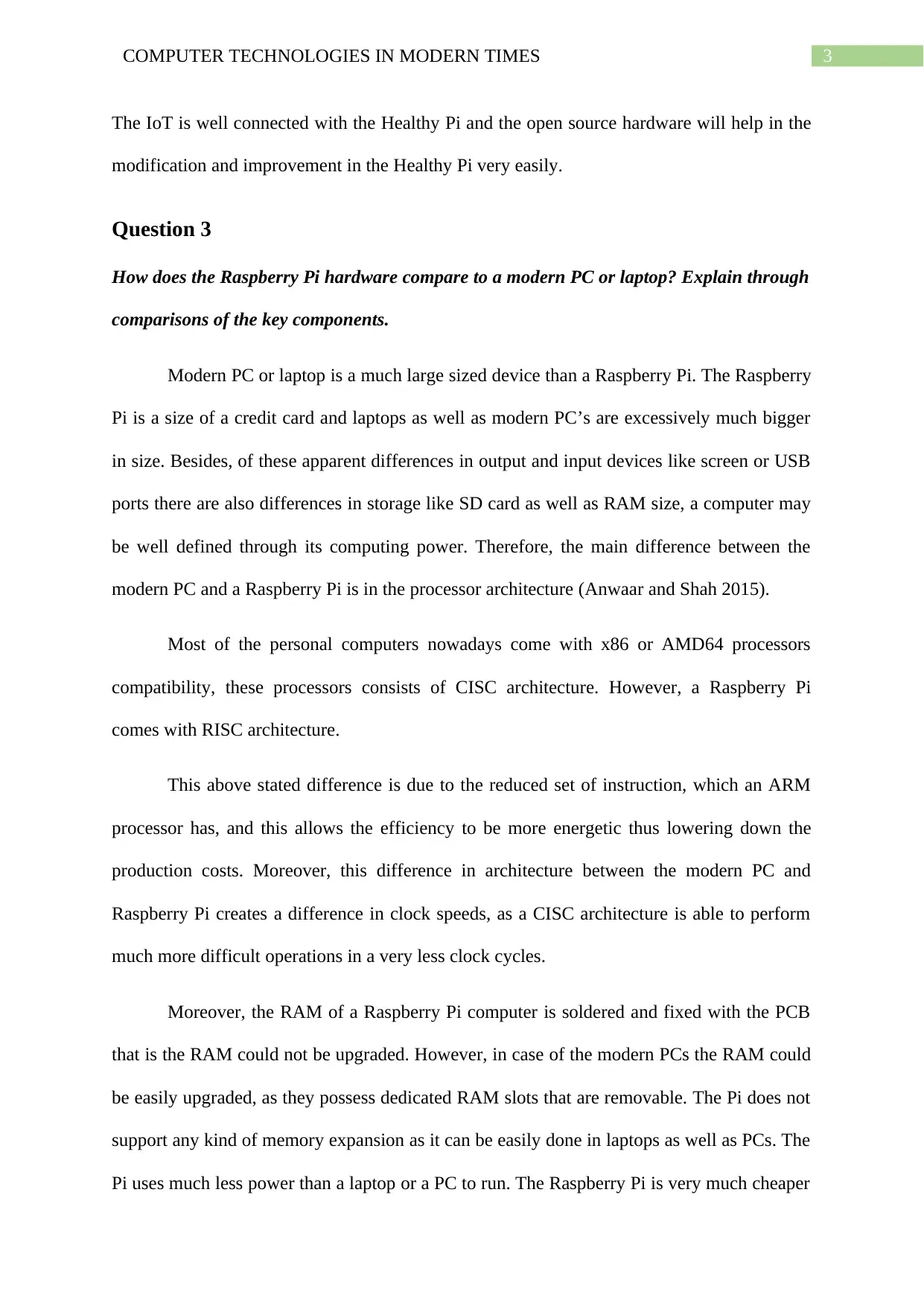
3COMPUTER TECHNOLOGIES IN MODERN TIMES
The IoT is well connected with the Healthy Pi and the open source hardware will help in the
modification and improvement in the Healthy Pi very easily.
Question 3
How does the Raspberry Pi hardware compare to a modern PC or laptop? Explain through
comparisons of the key components.
Modern PC or laptop is a much large sized device than a Raspberry Pi. The Raspberry
Pi is a size of a credit card and laptops as well as modern PC’s are excessively much bigger
in size. Besides, of these apparent differences in output and input devices like screen or USB
ports there are also differences in storage like SD card as well as RAM size, a computer may
be well defined through its computing power. Therefore, the main difference between the
modern PC and a Raspberry Pi is in the processor architecture (Anwaar and Shah 2015).
Most of the personal computers nowadays come with x86 or AMD64 processors
compatibility, these processors consists of CISC architecture. However, a Raspberry Pi
comes with RISC architecture.
This above stated difference is due to the reduced set of instruction, which an ARM
processor has, and this allows the efficiency to be more energetic thus lowering down the
production costs. Moreover, this difference in architecture between the modern PC and
Raspberry Pi creates a difference in clock speeds, as a CISC architecture is able to perform
much more difficult operations in a very less clock cycles.
Moreover, the RAM of a Raspberry Pi computer is soldered and fixed with the PCB
that is the RAM could not be upgraded. However, in case of the modern PCs the RAM could
be easily upgraded, as they possess dedicated RAM slots that are removable. The Pi does not
support any kind of memory expansion as it can be easily done in laptops as well as PCs. The
Pi uses much less power than a laptop or a PC to run. The Raspberry Pi is very much cheaper
The IoT is well connected with the Healthy Pi and the open source hardware will help in the
modification and improvement in the Healthy Pi very easily.
Question 3
How does the Raspberry Pi hardware compare to a modern PC or laptop? Explain through
comparisons of the key components.
Modern PC or laptop is a much large sized device than a Raspberry Pi. The Raspberry
Pi is a size of a credit card and laptops as well as modern PC’s are excessively much bigger
in size. Besides, of these apparent differences in output and input devices like screen or USB
ports there are also differences in storage like SD card as well as RAM size, a computer may
be well defined through its computing power. Therefore, the main difference between the
modern PC and a Raspberry Pi is in the processor architecture (Anwaar and Shah 2015).
Most of the personal computers nowadays come with x86 or AMD64 processors
compatibility, these processors consists of CISC architecture. However, a Raspberry Pi
comes with RISC architecture.
This above stated difference is due to the reduced set of instruction, which an ARM
processor has, and this allows the efficiency to be more energetic thus lowering down the
production costs. Moreover, this difference in architecture between the modern PC and
Raspberry Pi creates a difference in clock speeds, as a CISC architecture is able to perform
much more difficult operations in a very less clock cycles.
Moreover, the RAM of a Raspberry Pi computer is soldered and fixed with the PCB
that is the RAM could not be upgraded. However, in case of the modern PCs the RAM could
be easily upgraded, as they possess dedicated RAM slots that are removable. The Pi does not
support any kind of memory expansion as it can be easily done in laptops as well as PCs. The
Pi uses much less power than a laptop or a PC to run. The Raspberry Pi is very much cheaper
Paraphrase This Document
Need a fresh take? Get an instant paraphrase of this document with our AI Paraphraser
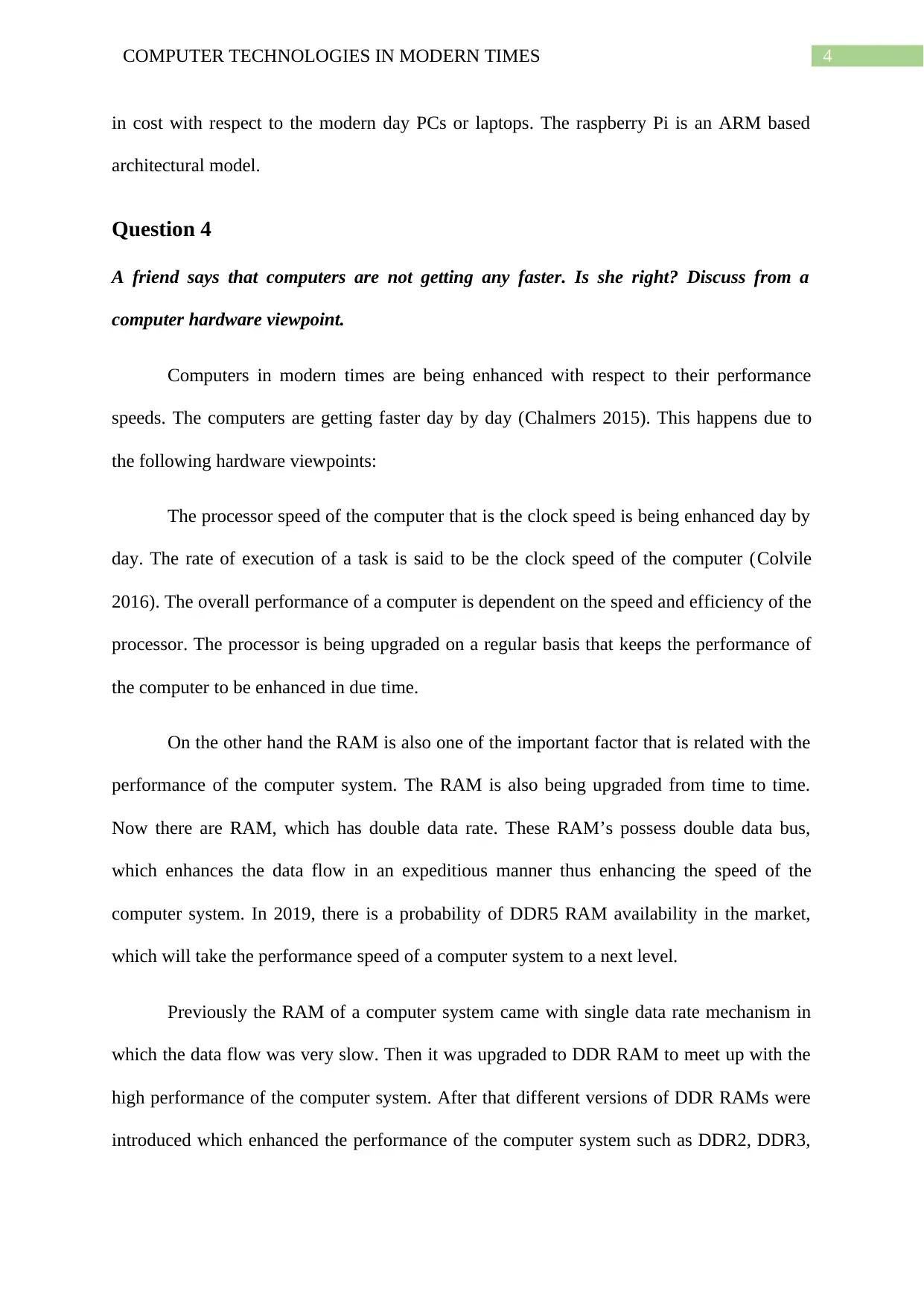
4COMPUTER TECHNOLOGIES IN MODERN TIMES
in cost with respect to the modern day PCs or laptops. The raspberry Pi is an ARM based
architectural model.
Question 4
A friend says that computers are not getting any faster. Is she right? Discuss from a
computer hardware viewpoint.
Computers in modern times are being enhanced with respect to their performance
speeds. The computers are getting faster day by day (Chalmers 2015). This happens due to
the following hardware viewpoints:
The processor speed of the computer that is the clock speed is being enhanced day by
day. The rate of execution of a task is said to be the clock speed of the computer (Colvile
2016). The overall performance of a computer is dependent on the speed and efficiency of the
processor. The processor is being upgraded on a regular basis that keeps the performance of
the computer to be enhanced in due time.
On the other hand the RAM is also one of the important factor that is related with the
performance of the computer system. The RAM is also being upgraded from time to time.
Now there are RAM, which has double data rate. These RAM’s possess double data bus,
which enhances the data flow in an expeditious manner thus enhancing the speed of the
computer system. In 2019, there is a probability of DDR5 RAM availability in the market,
which will take the performance speed of a computer system to a next level.
Previously the RAM of a computer system came with single data rate mechanism in
which the data flow was very slow. Then it was upgraded to DDR RAM to meet up with the
high performance of the computer system. After that different versions of DDR RAMs were
introduced which enhanced the performance of the computer system such as DDR2, DDR3,
in cost with respect to the modern day PCs or laptops. The raspberry Pi is an ARM based
architectural model.
Question 4
A friend says that computers are not getting any faster. Is she right? Discuss from a
computer hardware viewpoint.
Computers in modern times are being enhanced with respect to their performance
speeds. The computers are getting faster day by day (Chalmers 2015). This happens due to
the following hardware viewpoints:
The processor speed of the computer that is the clock speed is being enhanced day by
day. The rate of execution of a task is said to be the clock speed of the computer (Colvile
2016). The overall performance of a computer is dependent on the speed and efficiency of the
processor. The processor is being upgraded on a regular basis that keeps the performance of
the computer to be enhanced in due time.
On the other hand the RAM is also one of the important factor that is related with the
performance of the computer system. The RAM is also being upgraded from time to time.
Now there are RAM, which has double data rate. These RAM’s possess double data bus,
which enhances the data flow in an expeditious manner thus enhancing the speed of the
computer system. In 2019, there is a probability of DDR5 RAM availability in the market,
which will take the performance speed of a computer system to a next level.
Previously the RAM of a computer system came with single data rate mechanism in
which the data flow was very slow. Then it was upgraded to DDR RAM to meet up with the
high performance of the computer system. After that different versions of DDR RAMs were
introduced which enhanced the performance of the computer system such as DDR2, DDR3,
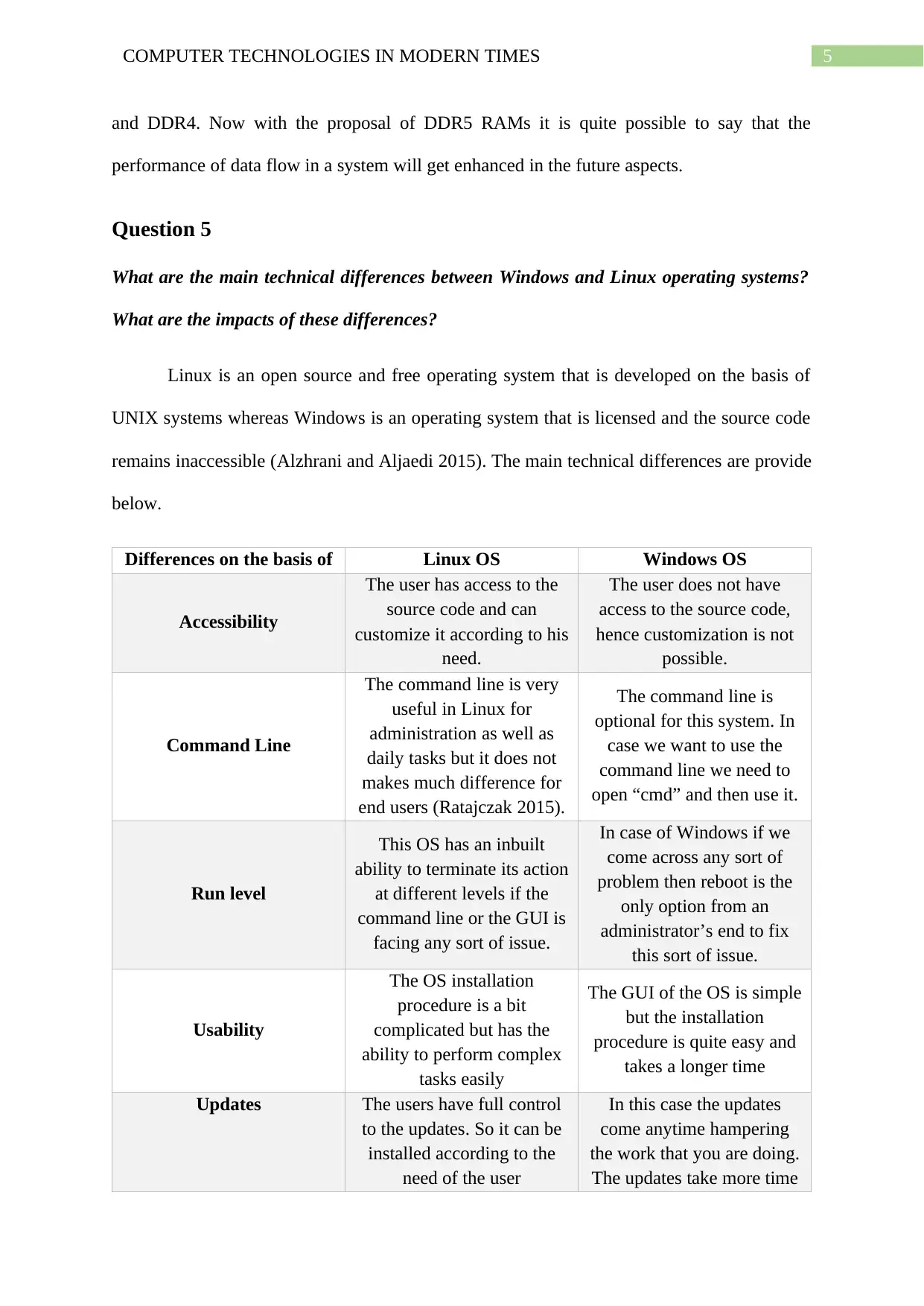
5COMPUTER TECHNOLOGIES IN MODERN TIMES
and DDR4. Now with the proposal of DDR5 RAMs it is quite possible to say that the
performance of data flow in a system will get enhanced in the future aspects.
Question 5
What are the main technical differences between Windows and Linux operating systems?
What are the impacts of these differences?
Linux is an open source and free operating system that is developed on the basis of
UNIX systems whereas Windows is an operating system that is licensed and the source code
remains inaccessible (Alzhrani and Aljaedi 2015). The main technical differences are provide
below.
Differences on the basis of Linux OS Windows OS
Accessibility
The user has access to the
source code and can
customize it according to his
need.
The user does not have
access to the source code,
hence customization is not
possible.
Command Line
The command line is very
useful in Linux for
administration as well as
daily tasks but it does not
makes much difference for
end users (Ratajczak 2015).
The command line is
optional for this system. In
case we want to use the
command line we need to
open “cmd” and then use it.
Run level
This OS has an inbuilt
ability to terminate its action
at different levels if the
command line or the GUI is
facing any sort of issue.
In case of Windows if we
come across any sort of
problem then reboot is the
only option from an
administrator’s end to fix
this sort of issue.
Usability
The OS installation
procedure is a bit
complicated but has the
ability to perform complex
tasks easily
The GUI of the OS is simple
but the installation
procedure is quite easy and
takes a longer time
Updates The users have full control
to the updates. So it can be
installed according to the
need of the user
In this case the updates
come anytime hampering
the work that you are doing.
The updates take more time
and DDR4. Now with the proposal of DDR5 RAMs it is quite possible to say that the
performance of data flow in a system will get enhanced in the future aspects.
Question 5
What are the main technical differences between Windows and Linux operating systems?
What are the impacts of these differences?
Linux is an open source and free operating system that is developed on the basis of
UNIX systems whereas Windows is an operating system that is licensed and the source code
remains inaccessible (Alzhrani and Aljaedi 2015). The main technical differences are provide
below.
Differences on the basis of Linux OS Windows OS
Accessibility
The user has access to the
source code and can
customize it according to his
need.
The user does not have
access to the source code,
hence customization is not
possible.
Command Line
The command line is very
useful in Linux for
administration as well as
daily tasks but it does not
makes much difference for
end users (Ratajczak 2015).
The command line is
optional for this system. In
case we want to use the
command line we need to
open “cmd” and then use it.
Run level
This OS has an inbuilt
ability to terminate its action
at different levels if the
command line or the GUI is
facing any sort of issue.
In case of Windows if we
come across any sort of
problem then reboot is the
only option from an
administrator’s end to fix
this sort of issue.
Usability
The OS installation
procedure is a bit
complicated but has the
ability to perform complex
tasks easily
The GUI of the OS is simple
but the installation
procedure is quite easy and
takes a longer time
Updates The users have full control
to the updates. So it can be
installed according to the
need of the user
In this case the updates
come anytime hampering
the work that you are doing.
The updates take more time
⊘ This is a preview!⊘
Do you want full access?
Subscribe today to unlock all pages.

Trusted by 1+ million students worldwide
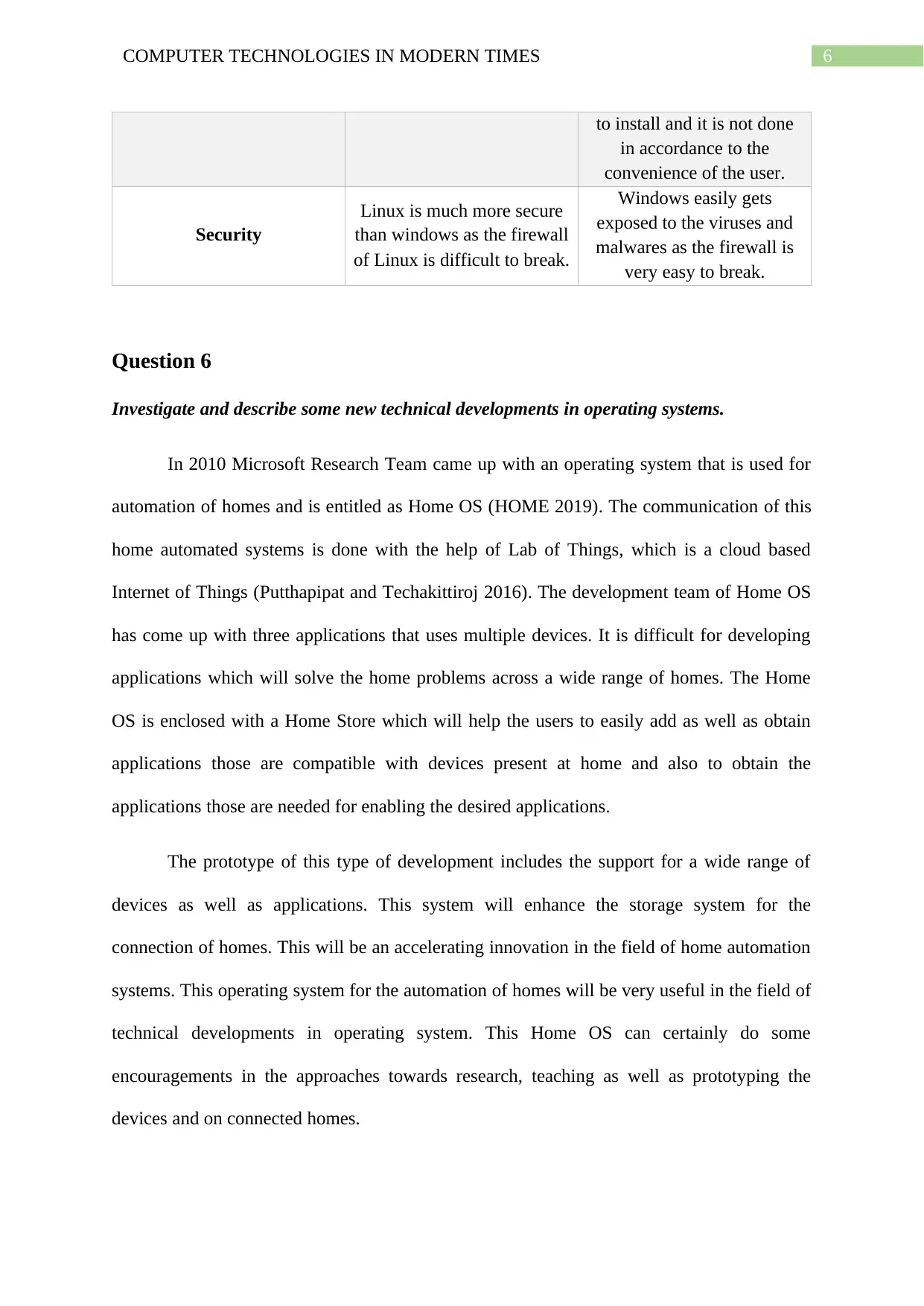
6COMPUTER TECHNOLOGIES IN MODERN TIMES
to install and it is not done
in accordance to the
convenience of the user.
Security
Linux is much more secure
than windows as the firewall
of Linux is difficult to break.
Windows easily gets
exposed to the viruses and
malwares as the firewall is
very easy to break.
Question 6
Investigate and describe some new technical developments in operating systems.
In 2010 Microsoft Research Team came up with an operating system that is used for
automation of homes and is entitled as Home OS (HOME 2019). The communication of this
home automated systems is done with the help of Lab of Things, which is a cloud based
Internet of Things (Putthapipat and Techakittiroj 2016). The development team of Home OS
has come up with three applications that uses multiple devices. It is difficult for developing
applications which will solve the home problems across a wide range of homes. The Home
OS is enclosed with a Home Store which will help the users to easily add as well as obtain
applications those are compatible with devices present at home and also to obtain the
applications those are needed for enabling the desired applications.
The prototype of this type of development includes the support for a wide range of
devices as well as applications. This system will enhance the storage system for the
connection of homes. This will be an accelerating innovation in the field of home automation
systems. This operating system for the automation of homes will be very useful in the field of
technical developments in operating system. This Home OS can certainly do some
encouragements in the approaches towards research, teaching as well as prototyping the
devices and on connected homes.
to install and it is not done
in accordance to the
convenience of the user.
Security
Linux is much more secure
than windows as the firewall
of Linux is difficult to break.
Windows easily gets
exposed to the viruses and
malwares as the firewall is
very easy to break.
Question 6
Investigate and describe some new technical developments in operating systems.
In 2010 Microsoft Research Team came up with an operating system that is used for
automation of homes and is entitled as Home OS (HOME 2019). The communication of this
home automated systems is done with the help of Lab of Things, which is a cloud based
Internet of Things (Putthapipat and Techakittiroj 2016). The development team of Home OS
has come up with three applications that uses multiple devices. It is difficult for developing
applications which will solve the home problems across a wide range of homes. The Home
OS is enclosed with a Home Store which will help the users to easily add as well as obtain
applications those are compatible with devices present at home and also to obtain the
applications those are needed for enabling the desired applications.
The prototype of this type of development includes the support for a wide range of
devices as well as applications. This system will enhance the storage system for the
connection of homes. This will be an accelerating innovation in the field of home automation
systems. This operating system for the automation of homes will be very useful in the field of
technical developments in operating system. This Home OS can certainly do some
encouragements in the approaches towards research, teaching as well as prototyping the
devices and on connected homes.
Paraphrase This Document
Need a fresh take? Get an instant paraphrase of this document with our AI Paraphraser
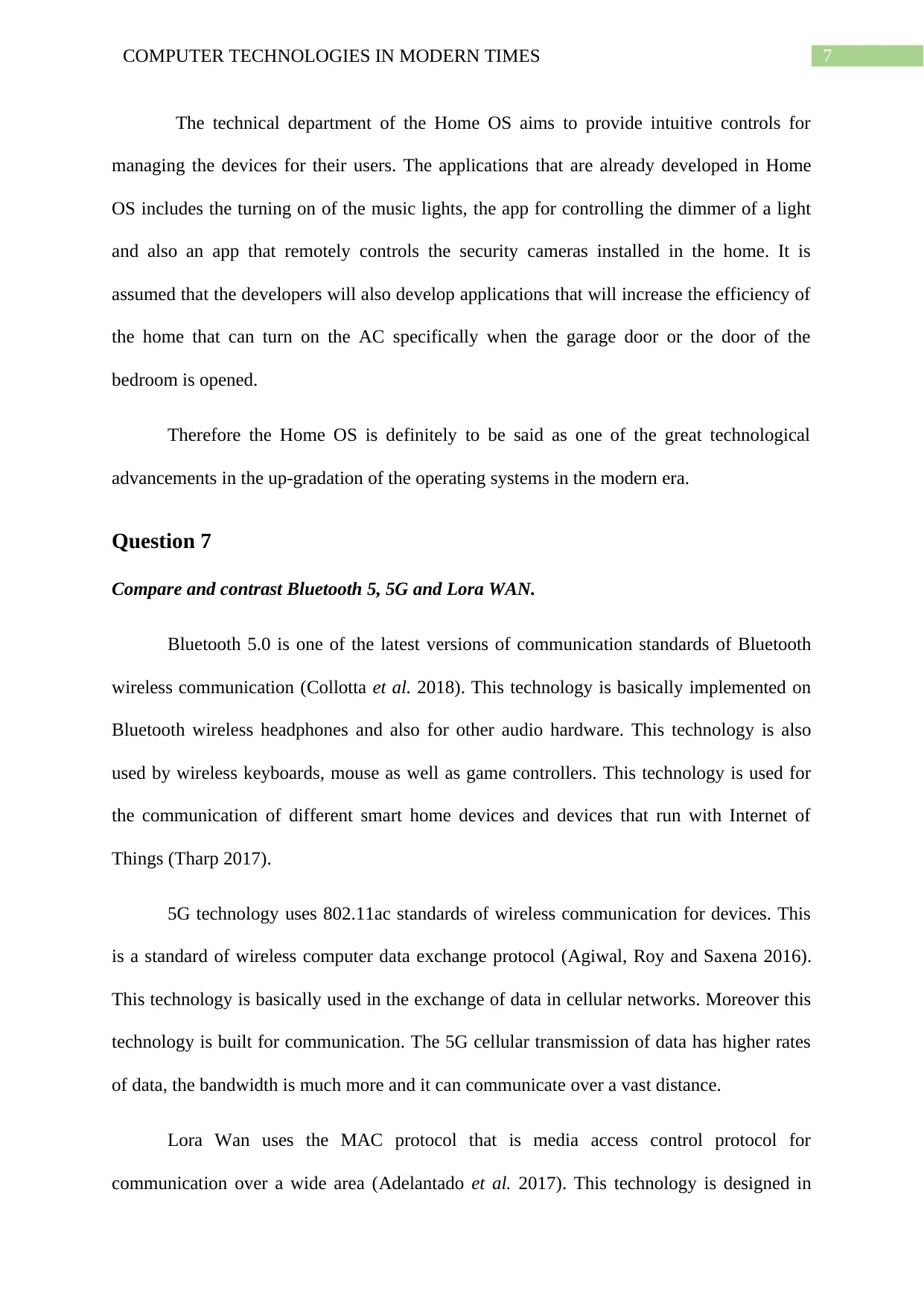
7COMPUTER TECHNOLOGIES IN MODERN TIMES
The technical department of the Home OS aims to provide intuitive controls for
managing the devices for their users. The applications that are already developed in Home
OS includes the turning on of the music lights, the app for controlling the dimmer of a light
and also an app that remotely controls the security cameras installed in the home. It is
assumed that the developers will also develop applications that will increase the efficiency of
the home that can turn on the AC specifically when the garage door or the door of the
bedroom is opened.
Therefore the Home OS is definitely to be said as one of the great technological
advancements in the up-gradation of the operating systems in the modern era.
Question 7
Compare and contrast Bluetooth 5, 5G and Lora WAN.
Bluetooth 5.0 is one of the latest versions of communication standards of Bluetooth
wireless communication (Collotta et al. 2018). This technology is basically implemented on
Bluetooth wireless headphones and also for other audio hardware. This technology is also
used by wireless keyboards, mouse as well as game controllers. This technology is used for
the communication of different smart home devices and devices that run with Internet of
Things (Tharp 2017).
5G technology uses 802.11ac standards of wireless communication for devices. This
is a standard of wireless computer data exchange protocol (Agiwal, Roy and Saxena 2016).
This technology is basically used in the exchange of data in cellular networks. Moreover this
technology is built for communication. The 5G cellular transmission of data has higher rates
of data, the bandwidth is much more and it can communicate over a vast distance.
Lora Wan uses the MAC protocol that is media access control protocol for
communication over a wide area (Adelantado et al. 2017). This technology is designed in
The technical department of the Home OS aims to provide intuitive controls for
managing the devices for their users. The applications that are already developed in Home
OS includes the turning on of the music lights, the app for controlling the dimmer of a light
and also an app that remotely controls the security cameras installed in the home. It is
assumed that the developers will also develop applications that will increase the efficiency of
the home that can turn on the AC specifically when the garage door or the door of the
bedroom is opened.
Therefore the Home OS is definitely to be said as one of the great technological
advancements in the up-gradation of the operating systems in the modern era.
Question 7
Compare and contrast Bluetooth 5, 5G and Lora WAN.
Bluetooth 5.0 is one of the latest versions of communication standards of Bluetooth
wireless communication (Collotta et al. 2018). This technology is basically implemented on
Bluetooth wireless headphones and also for other audio hardware. This technology is also
used by wireless keyboards, mouse as well as game controllers. This technology is used for
the communication of different smart home devices and devices that run with Internet of
Things (Tharp 2017).
5G technology uses 802.11ac standards of wireless communication for devices. This
is a standard of wireless computer data exchange protocol (Agiwal, Roy and Saxena 2016).
This technology is basically used in the exchange of data in cellular networks. Moreover this
technology is built for communication. The 5G cellular transmission of data has higher rates
of data, the bandwidth is much more and it can communicate over a vast distance.
Lora Wan uses the MAC protocol that is media access control protocol for
communication over a wide area (Adelantado et al. 2017). This technology is designed in
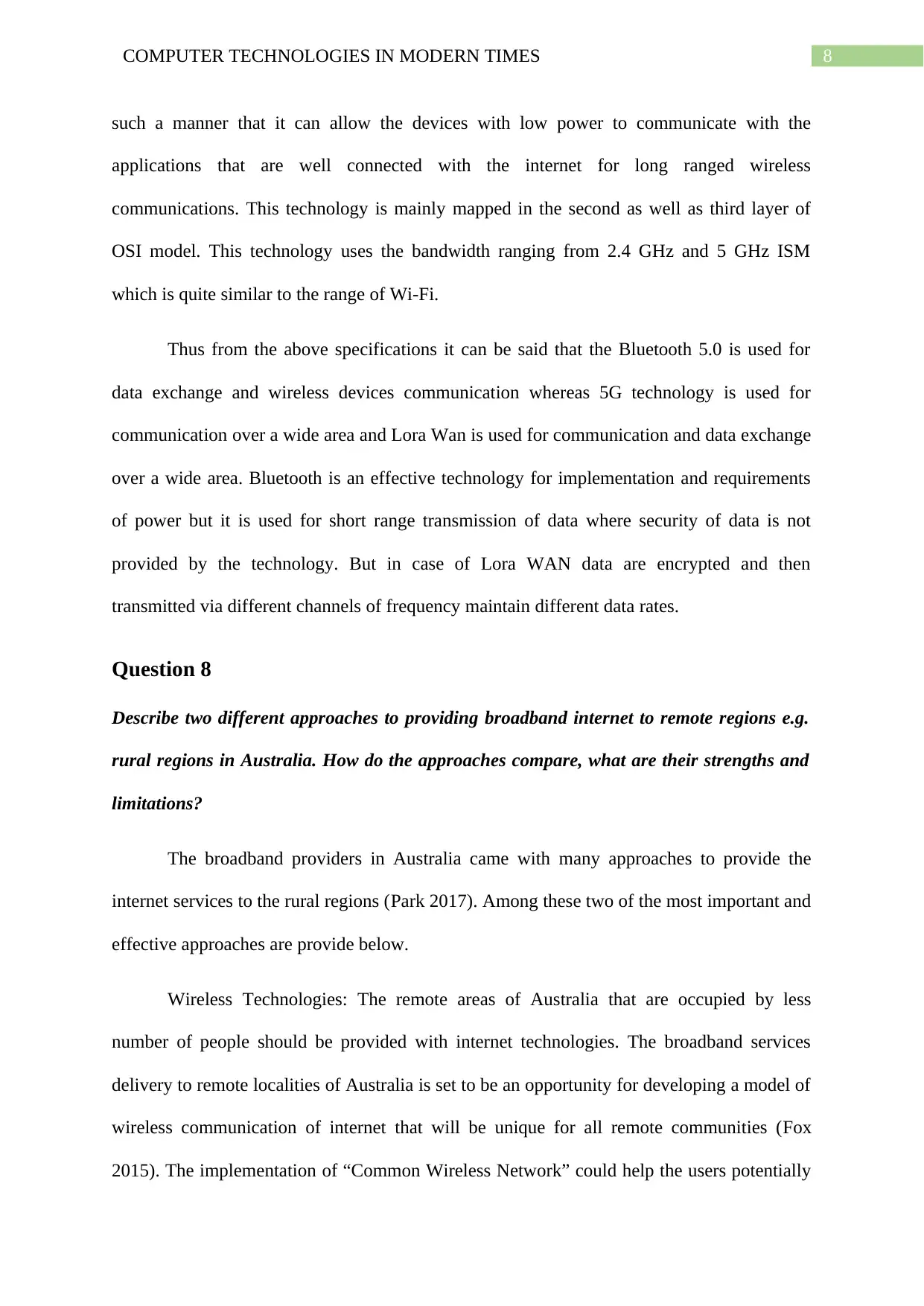
8COMPUTER TECHNOLOGIES IN MODERN TIMES
such a manner that it can allow the devices with low power to communicate with the
applications that are well connected with the internet for long ranged wireless
communications. This technology is mainly mapped in the second as well as third layer of
OSI model. This technology uses the bandwidth ranging from 2.4 GHz and 5 GHz ISM
which is quite similar to the range of Wi-Fi.
Thus from the above specifications it can be said that the Bluetooth 5.0 is used for
data exchange and wireless devices communication whereas 5G technology is used for
communication over a wide area and Lora Wan is used for communication and data exchange
over a wide area. Bluetooth is an effective technology for implementation and requirements
of power but it is used for short range transmission of data where security of data is not
provided by the technology. But in case of Lora WAN data are encrypted and then
transmitted via different channels of frequency maintain different data rates.
Question 8
Describe two different approaches to providing broadband internet to remote regions e.g.
rural regions in Australia. How do the approaches compare, what are their strengths and
limitations?
The broadband providers in Australia came with many approaches to provide the
internet services to the rural regions (Park 2017). Among these two of the most important and
effective approaches are provide below.
Wireless Technologies: The remote areas of Australia that are occupied by less
number of people should be provided with internet technologies. The broadband services
delivery to remote localities of Australia is set to be an opportunity for developing a model of
wireless communication of internet that will be unique for all remote communities (Fox
2015). The implementation of “Common Wireless Network” could help the users potentially
such a manner that it can allow the devices with low power to communicate with the
applications that are well connected with the internet for long ranged wireless
communications. This technology is mainly mapped in the second as well as third layer of
OSI model. This technology uses the bandwidth ranging from 2.4 GHz and 5 GHz ISM
which is quite similar to the range of Wi-Fi.
Thus from the above specifications it can be said that the Bluetooth 5.0 is used for
data exchange and wireless devices communication whereas 5G technology is used for
communication over a wide area and Lora Wan is used for communication and data exchange
over a wide area. Bluetooth is an effective technology for implementation and requirements
of power but it is used for short range transmission of data where security of data is not
provided by the technology. But in case of Lora WAN data are encrypted and then
transmitted via different channels of frequency maintain different data rates.
Question 8
Describe two different approaches to providing broadband internet to remote regions e.g.
rural regions in Australia. How do the approaches compare, what are their strengths and
limitations?
The broadband providers in Australia came with many approaches to provide the
internet services to the rural regions (Park 2017). Among these two of the most important and
effective approaches are provide below.
Wireless Technologies: The remote areas of Australia that are occupied by less
number of people should be provided with internet technologies. The broadband services
delivery to remote localities of Australia is set to be an opportunity for developing a model of
wireless communication of internet that will be unique for all remote communities (Fox
2015). The implementation of “Common Wireless Network” could help the users potentially
⊘ This is a preview!⊘
Do you want full access?
Subscribe today to unlock all pages.

Trusted by 1+ million students worldwide
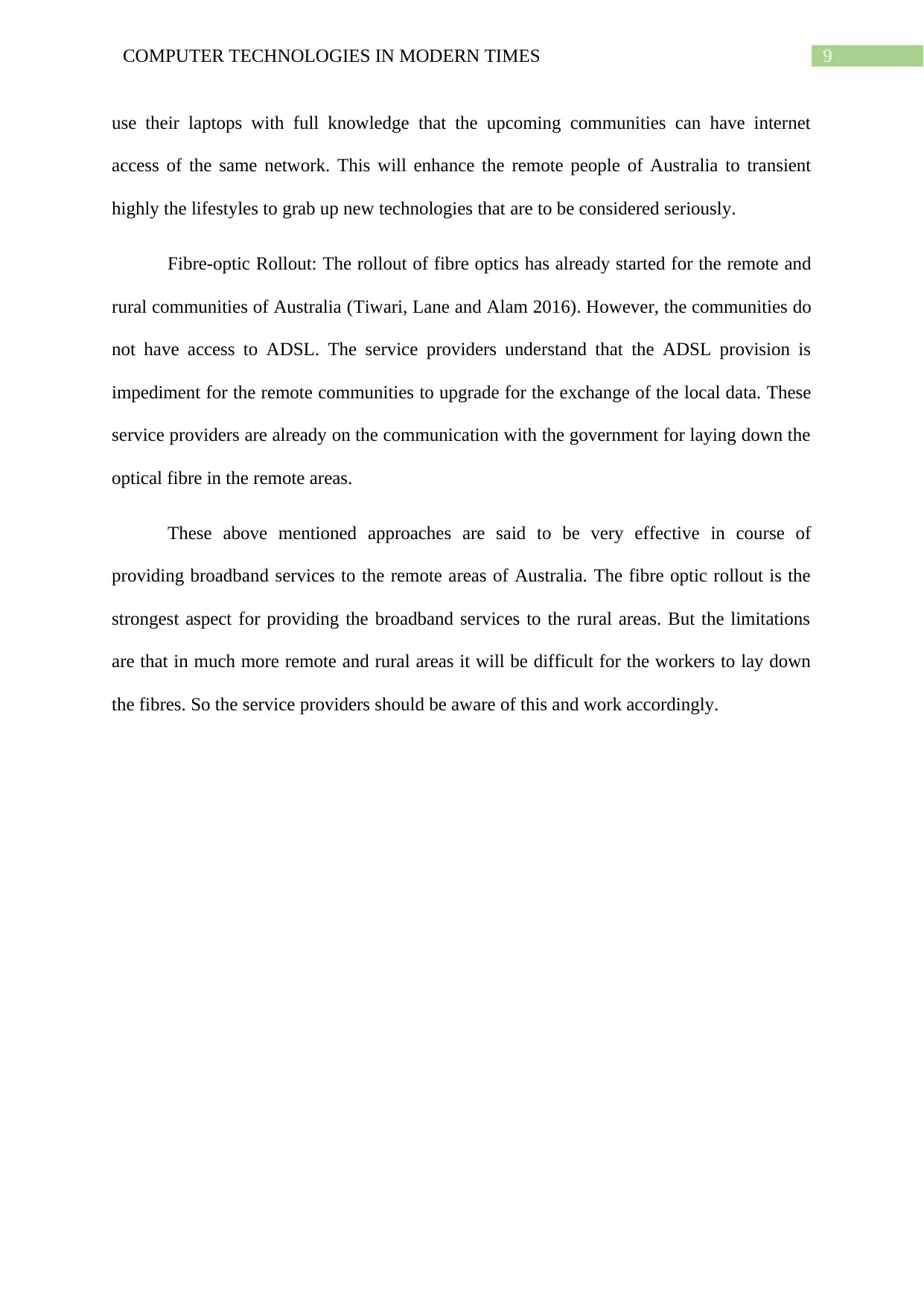
9COMPUTER TECHNOLOGIES IN MODERN TIMES
use their laptops with full knowledge that the upcoming communities can have internet
access of the same network. This will enhance the remote people of Australia to transient
highly the lifestyles to grab up new technologies that are to be considered seriously.
Fibre-optic Rollout: The rollout of fibre optics has already started for the remote and
rural communities of Australia (Tiwari, Lane and Alam 2016). However, the communities do
not have access to ADSL. The service providers understand that the ADSL provision is
impediment for the remote communities to upgrade for the exchange of the local data. These
service providers are already on the communication with the government for laying down the
optical fibre in the remote areas.
These above mentioned approaches are said to be very effective in course of
providing broadband services to the remote areas of Australia. The fibre optic rollout is the
strongest aspect for providing the broadband services to the rural areas. But the limitations
are that in much more remote and rural areas it will be difficult for the workers to lay down
the fibres. So the service providers should be aware of this and work accordingly.
use their laptops with full knowledge that the upcoming communities can have internet
access of the same network. This will enhance the remote people of Australia to transient
highly the lifestyles to grab up new technologies that are to be considered seriously.
Fibre-optic Rollout: The rollout of fibre optics has already started for the remote and
rural communities of Australia (Tiwari, Lane and Alam 2016). However, the communities do
not have access to ADSL. The service providers understand that the ADSL provision is
impediment for the remote communities to upgrade for the exchange of the local data. These
service providers are already on the communication with the government for laying down the
optical fibre in the remote areas.
These above mentioned approaches are said to be very effective in course of
providing broadband services to the remote areas of Australia. The fibre optic rollout is the
strongest aspect for providing the broadband services to the rural areas. But the limitations
are that in much more remote and rural areas it will be difficult for the workers to lay down
the fibres. So the service providers should be aware of this and work accordingly.
Paraphrase This Document
Need a fresh take? Get an instant paraphrase of this document with our AI Paraphraser
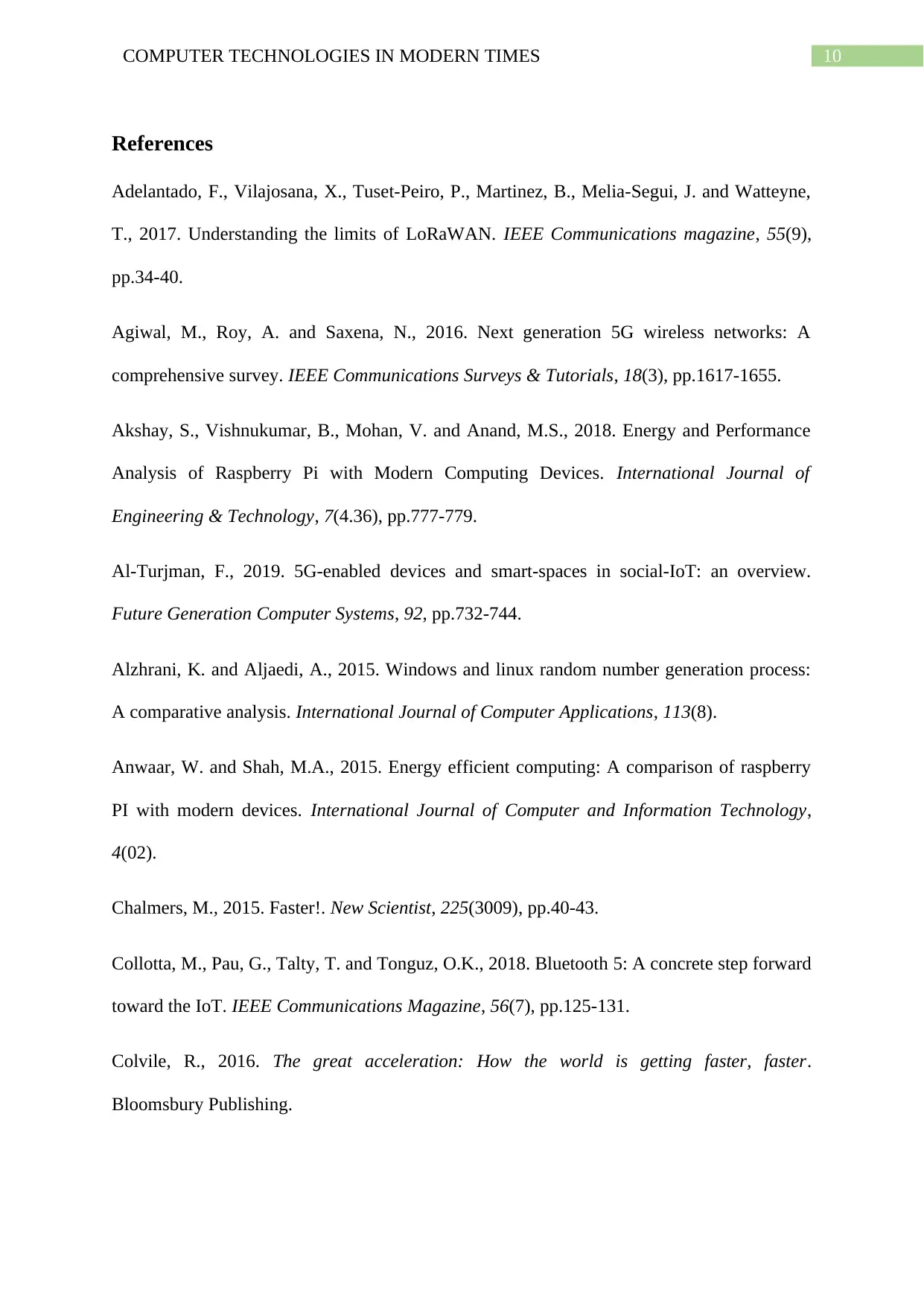
10COMPUTER TECHNOLOGIES IN MODERN TIMES
References
Adelantado, F., Vilajosana, X., Tuset-Peiro, P., Martinez, B., Melia-Segui, J. and Watteyne,
T., 2017. Understanding the limits of LoRaWAN. IEEE Communications magazine, 55(9),
pp.34-40.
Agiwal, M., Roy, A. and Saxena, N., 2016. Next generation 5G wireless networks: A
comprehensive survey. IEEE Communications Surveys & Tutorials, 18(3), pp.1617-1655.
Akshay, S., Vishnukumar, B., Mohan, V. and Anand, M.S., 2018. Energy and Performance
Analysis of Raspberry Pi with Modern Computing Devices. International Journal of
Engineering & Technology, 7(4.36), pp.777-779.
Al-Turjman, F., 2019. 5G-enabled devices and smart-spaces in social-IoT: an overview.
Future Generation Computer Systems, 92, pp.732-744.
Alzhrani, K. and Aljaedi, A., 2015. Windows and linux random number generation process:
A comparative analysis. International Journal of Computer Applications, 113(8).
Anwaar, W. and Shah, M.A., 2015. Energy efficient computing: A comparison of raspberry
PI with modern devices. International Journal of Computer and Information Technology,
4(02).
Chalmers, M., 2015. Faster!. New Scientist, 225(3009), pp.40-43.
Collotta, M., Pau, G., Talty, T. and Tonguz, O.K., 2018. Bluetooth 5: A concrete step forward
toward the IoT. IEEE Communications Magazine, 56(7), pp.125-131.
Colvile, R., 2016. The great acceleration: How the world is getting faster, faster.
Bloomsbury Publishing.
References
Adelantado, F., Vilajosana, X., Tuset-Peiro, P., Martinez, B., Melia-Segui, J. and Watteyne,
T., 2017. Understanding the limits of LoRaWAN. IEEE Communications magazine, 55(9),
pp.34-40.
Agiwal, M., Roy, A. and Saxena, N., 2016. Next generation 5G wireless networks: A
comprehensive survey. IEEE Communications Surveys & Tutorials, 18(3), pp.1617-1655.
Akshay, S., Vishnukumar, B., Mohan, V. and Anand, M.S., 2018. Energy and Performance
Analysis of Raspberry Pi with Modern Computing Devices. International Journal of
Engineering & Technology, 7(4.36), pp.777-779.
Al-Turjman, F., 2019. 5G-enabled devices and smart-spaces in social-IoT: an overview.
Future Generation Computer Systems, 92, pp.732-744.
Alzhrani, K. and Aljaedi, A., 2015. Windows and linux random number generation process:
A comparative analysis. International Journal of Computer Applications, 113(8).
Anwaar, W. and Shah, M.A., 2015. Energy efficient computing: A comparison of raspberry
PI with modern devices. International Journal of Computer and Information Technology,
4(02).
Chalmers, M., 2015. Faster!. New Scientist, 225(3009), pp.40-43.
Collotta, M., Pau, G., Talty, T. and Tonguz, O.K., 2018. Bluetooth 5: A concrete step forward
toward the IoT. IEEE Communications Magazine, 56(7), pp.125-131.
Colvile, R., 2016. The great acceleration: How the world is getting faster, faster.
Bloomsbury Publishing.

11COMPUTER TECHNOLOGIES IN MODERN TIMES
Fox, J., 2015. Satellite Delivered Broadband to Australian Outback Communities. In 33rd
AIAA International Communications Satellite Systems Conference and Exhibition (p. 4302).
HOME OS, O. (2019). HomeOS: Enabling smarter homes for everyone - Microsoft Research.
[online] Microsoft Research. Available at:
https://www.microsoft.com/en-us/research/project/homeos-enabling-smarter-homes-for-
everyone/ [Accessed 21 Mar. 2019].
Koshti, M., Ganorkar, S. and Chiari, L., 2016. IoT Based Health Monitoring System by
Using Raspberry Pi and ECG Signal. International Journal of Innovative Research in
Science, Engineering and Technology, 5(5).
Kumar, R. and Rajasekaran, M.P., 2016, January. An IoT based patient monitoring system
using raspberry Pi. In 2016 International Conference on Computing Technologies and
Intelligent Data Engineering (ICCTIDE'16) (pp. 1-4). IEEE.
Park, S., 2017. Digital inequalities in rural Australia: A double jeopardy of remoteness and
social exclusion. Journal of Rural Studies, 54, pp.399-407.
Putthapipat, P. and Techakittiroj, K., 2016, January. PiFrame: A framework for home
automation platform on the full feature OS. In 2016 International Conference on Electronics,
Information, and Communications (ICEIC) (pp. 1-4). IEEE.
Ratajczak, D., 2015. Is Linux a better desktop operating system than Microsoft Windows?.
GRIN Verlag.
Tharp, J.D., 2017. Replication system for low power internet of things devices (Doctoral
dissertation).
Fox, J., 2015. Satellite Delivered Broadband to Australian Outback Communities. In 33rd
AIAA International Communications Satellite Systems Conference and Exhibition (p. 4302).
HOME OS, O. (2019). HomeOS: Enabling smarter homes for everyone - Microsoft Research.
[online] Microsoft Research. Available at:
https://www.microsoft.com/en-us/research/project/homeos-enabling-smarter-homes-for-
everyone/ [Accessed 21 Mar. 2019].
Koshti, M., Ganorkar, S. and Chiari, L., 2016. IoT Based Health Monitoring System by
Using Raspberry Pi and ECG Signal. International Journal of Innovative Research in
Science, Engineering and Technology, 5(5).
Kumar, R. and Rajasekaran, M.P., 2016, January. An IoT based patient monitoring system
using raspberry Pi. In 2016 International Conference on Computing Technologies and
Intelligent Data Engineering (ICCTIDE'16) (pp. 1-4). IEEE.
Park, S., 2017. Digital inequalities in rural Australia: A double jeopardy of remoteness and
social exclusion. Journal of Rural Studies, 54, pp.399-407.
Putthapipat, P. and Techakittiroj, K., 2016, January. PiFrame: A framework for home
automation platform on the full feature OS. In 2016 International Conference on Electronics,
Information, and Communications (ICEIC) (pp. 1-4). IEEE.
Ratajczak, D., 2015. Is Linux a better desktop operating system than Microsoft Windows?.
GRIN Verlag.
Tharp, J.D., 2017. Replication system for low power internet of things devices (Doctoral
dissertation).
⊘ This is a preview!⊘
Do you want full access?
Subscribe today to unlock all pages.

Trusted by 1+ million students worldwide
1 out of 13
Related Documents
Your All-in-One AI-Powered Toolkit for Academic Success.
+13062052269
info@desklib.com
Available 24*7 on WhatsApp / Email
![[object Object]](/_next/static/media/star-bottom.7253800d.svg)
Unlock your academic potential
Copyright © 2020–2025 A2Z Services. All Rights Reserved. Developed and managed by ZUCOL.





